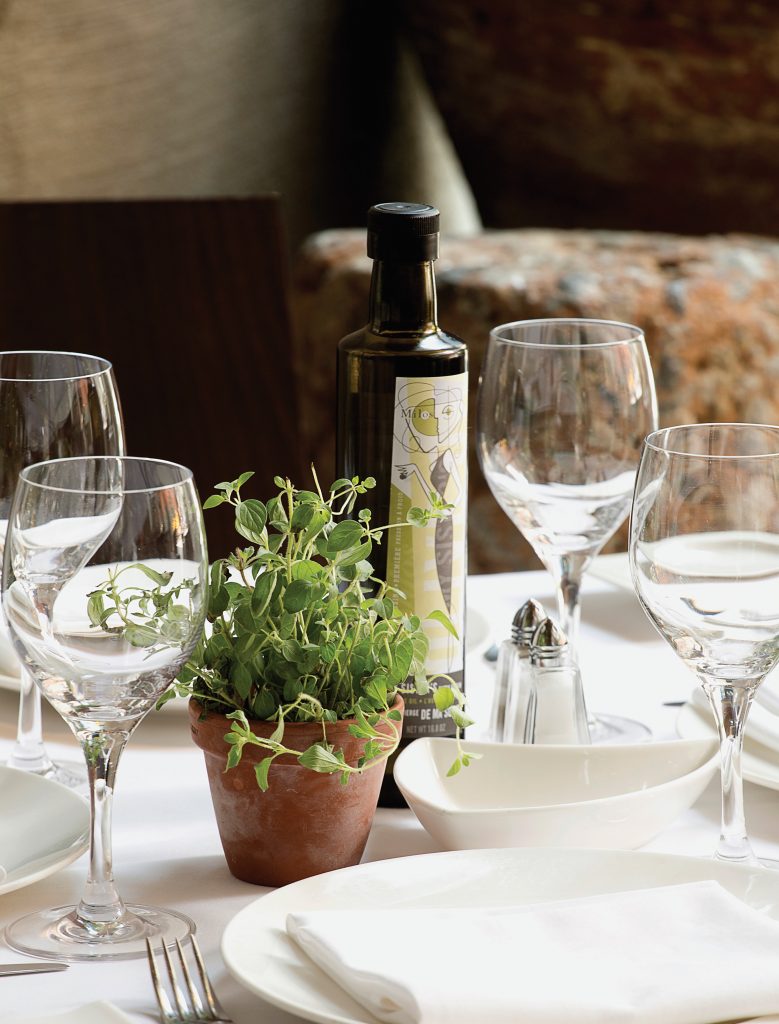Menu Options
Posted by estiator at 7 June, at 04 : 24 AM Print
In the COVID era, the next generation of menus is changing how we serve customers.
By Michael Kaminer
To paraphrase Mark Twain, reports of the death of dining out have been greatly exaggerated. Nearly 60% of Americans feel comfortable at restaurants, according to an April survey by data company Morning Consult—and that number keeps growing.
But as Estiator readers know all too well, every aspect of the experience has changed. And some of the biggest pivots have come with menus.
While the old printed menu isn’t dead, it may never come back in its previous form. The pandemic, and the desire for minimal points of contact from consumers, has guaranteed that. But paper isn’t disappearing. It’s just becoming part of a next-generation mix of print and digital that can offer terrific opportunities to reconnect with customers—if it’s done right.
“What we’re going to see is a set of hybrid menus,” says Dr. Alex Susskind, professor of food and beverage management and the director of the Cornell Institute of Food and Beverage Management. “It’ll depend on what type of operation you run, and what kind of patrons you serve. Those needs weren’t well-defined a year ago. They are now.”
Post-COVID, menus have been appearing in three basic forms. Paper menus have persisted, but in more compact, highly edited forms. Those now-ubiquitous QR codes, which smartphones scan to open a web page, will keep growing in popularity. They may open a simple web page or a menu pdf that patrons can download. Some operators have started linking QE codes to online order platforms that let customers order, and pay, from the table. Still other restaurateurs are providing tablets that allow digital options for ordering and payment. Technology has adapted so quickly that more menu iterations may appear on the scene by the time you read this.
Along with hygiene concerns, the changes have been driven by huge increases in takeout and delivery, Prof. Susskind tells Estiator. “Even if your indoor dining business is back, you don’t want to let go of the delivery and takeout business you’ve built, so that has forced restaurants to change the content and the extent of menus,” he says. “If you’re a luxury restaurant, you might have cut your 50 menu items down to 25 to make sure they all travel well and that your staff can handle them. Menus reflect those adjustments.”
Diner restaurants face special challenges, Prof. Susskind said, since so many of them offer “phone-book-style” menus as a point of pride. “I’m a big fan,” he said. “Every community should have one of those restaurants, if not 20. But those operators have to focus on dayparts and what’s most important at those dayparts. Someone will want eggs at 11pm—fine. But it may not be OK to have three different versions of a sandwich for the time being.”
His advice: “Focus on what sells. Sales and data-driven decisions always work best. It’s fine if your menu goes from 10 to eight pages, as long as you’re taking out stuff that doesn’t sell. It’s like an audio knob—adjust it dynamically. Keep your ear on the ground, and understand what guests are comfortable with.”
Tom Stavrakis, familiar to Estiator readers as founder of New Jersey menu consultants Restaurant Graphics, agrees. “Check your POS. If something doesn’t sell, get rid of it,” says Stavrakis, whose clients include diners nation-wide. “Limit your menu. Limit your inventory. Control your staff. Highlight fewer items that are more profitable. You’ll be better off.”

Stavrakis advised his clients to cut down menus when the pandemic started. “I realized those giant dinner menus would be too hard to sanitize. I suggested trimming them down to one page, front and back, and laminated,” he says. “I advised them to keep around some paper menus of the same type, and get a QR code.”
For clients concerned that shorter menus could compromise hospitality at their restaurants, Stavrakis says it doesn’t have to be that way. “You’ll always have the die-hard who only wants one thing, but that one thing doesn’t have to be on the menu,” he says. “If a customer asks for something you’ve cut, tell them you’ll make it if you have the ingredients.”
While Stavrakis says some clients are “reverting back to those big-ass menus,” a lot of them are sticking with QR codes for now. “Digital menus are a lot less expensive to produce. And a lot of clients are actually happier with limited menus.” Demand for digital services got so high in 2020 that Stavrakis launched Dinerbites, a new digital ordering platform, in April.
The biggest issue from diner customers with online ordering has been “modifiers, add-ons, and special requests,” says Stavrakis, who adds that he’s been working on solutions. “I think like a waitress,” he jokes. “Third-party delivery services don’t understand diner menus like I do.”
A digital menu doesn’t have to mean a radical departure from the printed version, Stavrakis says. “Whatever works for a plastic menu is going to work for a PDF,” he says. “The menu has to be laid out in good order. It has to make sense. It should be clean, with a font that’s easy to read.” Digital or PDF menus differ from QR-code ordering, where menus might resemble online-ordering platforms, he said.
“Look, COVID advanced all of this by 10 years,” Stavrakis says. “Paper will likely be gone from diners in 10 to 15 years. But right now, they should have all three: paper, a PDF menu, and tablets.”
Paper and QR-code menus will continue to dominate, predicts Steven Hall, a veteran communications consultant whose clients have included restaurants in the U.S. and Japan. “Higher-end places will still like to have paper menus,” says Hall, president and founder of Hall PR in New York. “But menus have become shorter, with fewer items, less graphics, and more straightforward and to-the-point descriptions. That’s necessary if you’re reading a menu on a device.”

While the new generation of menus don’t leave as much room for personality, especially online, they do open up new opportunities for marketing, Hall says. “I used to love those little sayings on menus, but I’m not sure people read them,” he says. “You can be clever and brand yourself with a table tent, a cocktail napkin, or a coaster.” Online menus should feature a restaurant’s brand or logo prominently, he advises.
In the days of paper menus, some restaurateurs would also use check presenters to share marketing material, “but that wasn’t cost-effective, because people threw them away,” Hall says. Because online ordering or payment usually involves capturing email addresses, “you can now just email guests to remind them of special events.” The hardest thing to adapt to digital is the wine list, Hall says. “That still needs to get presented as a book, because if it’s a long list, people will scroll and scroll and scroll,” he notes. “Touchpads offer a solution, but they’re going around communally, and I advise clients not to use anything that’s shared.”
At Estiatorio Milos, the luxury Greek seafood restaurant with locations around the world, QR codes have helped customers access extensive wine lists as printed menus got retired, says Tanja Yokum, vice president of marketing and public relations.
“QR codes have been effective as a way of sharing our wine lists with guests during the pandemic,” Yokum tells Estiator. “They have been a solution to the need for single-use menus, and in our case at Milos, our wine lists are longer than a few pages and normally bound in a book. Guests have responded well to them in general. They are able to read the wine list on their phone, talk to our team about what style of wine they are looking to enjoy with their meal, and make a selection. While some miss the older style of printed books, the QR codes have been a good communication tool during this past year.”
No matter how many types of menus a restaurant offers, the net result is “fewer points of contact” than servers and customers used to have, according to Kate Edwards, founder of Manhattan hospitality consultants Kate Edwards & Company. Without the ritual of passing out printed menus, “it’s one less step of service,” Edwards tells Estiator. “Servers and staff are coming to the table a bit less. It used to be a sign of hospitality to do that. Now people find it overbearing.”
Operators will have to compensate in other ways. “I teach restaurant management, and the menu is the only sales tool you have,” Edwards says. “It has to work harder to describe food clearly. Options have to be clearly communicated. The menu should enable your customer to make the best decision possible.”
But Edwards also counsels that digital menus offer opportunities to guide behavior. “A digital menu can say, ‘We recommend x’, or ‘Check out our wine pairings,’” she said. “Online menus also allow the reader to control the size of fonts, which is nice—dark paper and a small font can be a deal breaker.”
And don’t forget dessert, Edwards says. “Dessert menus are sometimes forgotten,” she notes. “Dessert is a great experience addition, and a great addition to the check. I’ve seen tiny dessert cards on tables, which a server can come over and highlight. You might be assuming guests are seeing your dessert menus if they’ve opened a QR code, but they need to get prompted.”
In other words, suggesting a sweeter experience to guests can provide a sweetened bottom line for you.
❝
Greek food is all about shared plates. But today, you’ll probably be serving them in smaller, individual portions—people don’t want to dip into the same bowl that other people have. Leave the description as is on your menu, but surprise patrons by bringing the dish to the table portioned out. They’ll be grateful and feel like you took care of them.”
—STEVEN HALL, OWNER,
HALL PR, NEW YORK
❝
You should have all three options: QR codes, tablets, and paper menus. And embrace online ordering and takeout if you haven’t. Make the necessary adjustments and cuts to your menu. If you’re a good healthy diner, you’ll be even better as a result.”
—TOM STAVRAKIS, FOUNDER,
RESTAURANT GRAPHICS
AND DINERBITES, NJ
❝
The classic problem for diner operators: Sometimes vegan or vegetarian items tend to be less big sellers, but you may need those items to round out the menu so you don’t get the ‘no’ vote. You have to be careful about it, but it’s not impossible to work that out.”
—ALEX SUSSKIND, PROFESSOR OF FOOD AND BEVERAGE MAN-AGEMENT AND ASSOCIATE DEAN FOR ACADEMIC AFFAIRS AT THE SCHOOL OF HOTEL ADMINISTRA-TION, SC JOHNSON COLLEGE OF BUSINESS, CORNELL UNIVERSITY
❝
When it became clear paper menus weren’t returning, I had a client who sent an email to customers saying that servers wouldn’t be coming to tables as much. I thought that was really smart—he managed their expectations around hospitality.”
—KATE EDWARDS, FOUNDER,
KATE EDWARDS & COMPANY,
NEW YORK















